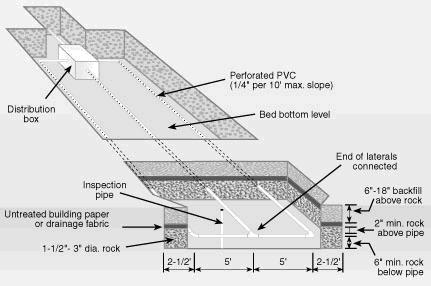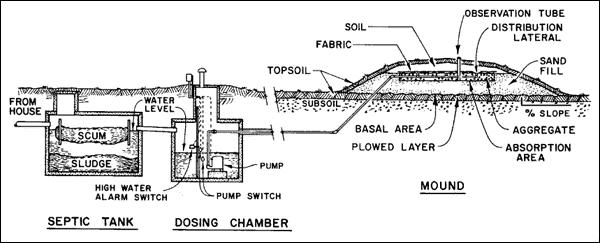Septic Tanks - 2...
Do You Use a Septic Tank ?...
Properly operated and maintained, a septic system can provide economical and effective sewage treatment for your
residence. Wastewater or sewage contains many contaminants from solid materials, such as toilet paper to floating
materials such as fats, oils and greases (FOG). In addition, plant nutrients, such as nitrogen and phosphorous, and pathogens, such as viruses and bacteria, are normal constituents of wastewater. If you use septic tanks and drain
fields or sand mounds for treating your household wastewater, you have to do more than forget about it and hope it
continues to operate properly. This page and related pages provide important information about your system, how it
works, how to properly operate and maintain it and how it can fail and what to do if it does fail.
How a Septic Tank Works ?...
A septic tank system consists of two or three segments. The first is the septic tank itself. A second component is some type of distribution system. The final component is a drain field, also referred to as an absorption field, leach filed,
or a seepage bed. Some systems may include a pump after the septic tank and before the drain field. This page looks at
how each of these operate. Later pages will discuss how the system fails and what failure means, and how to properly
operate and maintain your system. See diagram below for an overview of the septic system. Proper operation and maintenance of the septic system is covered on the O & M page, and the reasons for system failures and how to prevent and correct failures is covered on the failure page.
 Septic Tanks...
A septic tank is a one or two chamber vault made of concrete, fiberglass, steel, or designed as one piece. The tank's purpose is to separate solids that are in the wastewater from the water which then flows to the drain field, and to keep floating materials out of the water. The diagram below shows the three layers that occur in the tank. The bottom layer
is referred to as sludge and the top layer is called scum. The middle layer is clarified wastewater and flows on to the drain field for additional treatment.
Septic Tanks...
A septic tank is a one or two chamber vault made of concrete, fiberglass, steel, or designed as one piece. The tank's purpose is to separate solids that are in the wastewater from the water which then flows to the drain field, and to keep floating materials out of the water. The diagram below shows the three layers that occur in the tank. The bottom layer
is referred to as sludge and the top layer is called scum. The middle layer is clarified wastewater and flows on to the drain field for additional treatment.

In a septic tank, the wastewater flows from toilets, showers, tub drains, kitchen sinks, dishwashers, and clothes washers
to the tank. it enters the inlet baffle, where it is directed downward. The water flows slowly through the tank, this allows solids heavier than water to drop down to the sludge and material that is lighter than water to float to the scum layer. An outlet baffle directs the clarified water to the drain field or to a pump where it is sent to a sand mound or other treatment device. There are two inspection pipes located near the baffle, and a 20-24" manhole located in the
center. The inspection pipes allow an inspector to evaluate the scum and sludge layer to determine whether pumping is required. The manhole allows for a septage hauler to pump out the tank once every three to five years. Some septic tanks have an internal baffle to separate the tank into two chambers. Many states are now requiring this type of tank. With
two chambers, better treatment occurs. Septic tanks must be designed and installed by a licensed professional. Proper operation and maintenance of a septic tank system is discussed on the Septic Tank O & M Page.
Absorption Fields...
The majority of the treatment of the wastewater occurs in the absorption field. The soil provides final treatment. Uncompacted, unsaturated and undisturbed soil must be used to provide optimum treatment. The soil absorbs the pathogens
in the water and does not support their continued growth and they die. Nutrients, such as nitrogen and phosphorous absorb
to the soil particles or react with chemicals in the soil to remove them. Natural bacteria thrive in the soil and provide additional treatment. The cleansed water then flows to groundwater or nearby surface water such as lakes, ponds, rivers
or the ocean. The absorption field may consist of a series of trenches or several beds. See the diagrams below for illustrations of absorption trenches and absorption beds :


For a trench system, the trenches are cut 18-36 inches wide to a depth of approximately one foot deep. A 6-12 inch layer
of gravel is placed on the bottom of the trench, and 3/4-2 inch diameter perforated pipe is placed above the gravel. Additional gravel is added to about 2 inches above the pipe, and the remaining trench is filled with soil. A 6 -12 inch layer of top soil is added and the trench is seeded with grass. Trenches must be cut level and cannot exceed a length of
100 feet. Parallel trenches are used to ensure adequate treatment. trenches are generally 3-5 feet apart from center to center. A typical bed is about fifteen feet in width. The various layers are similar to trenches. Proper design and installation of the field is critical to ensuring proper and complete treatment. Design professionals licensed by the state must be used to design the entire septic system and ensure that the soils are appropriate for use of the field system. Unsaturated soil is necessary to provide oxygen to promote chemical reactions or bacterial degradation. Therefore soils
with groundwater that is at least 2-3 feet below the trenches are essential to promote proper treatment. The type of soil
is also important. Soils such as sand allow the water to percolate downward. This will enhance treatment and prevent
water from flow upward to the surface. Clay soils are less ideal, because the water does not flow as readily through it,
and areas with shallow bedrock, do not allow the use of absorption fields at all. Generally, a percolation test is
performed by a licensed professional to ensure that the soil is appropriate for use in the system. Proper design may also require that an additional area be set aside in case the current system fails. Some states and counties may also require
the installation of the additional field, and that the owner alternate between fields once every 6 months or years.
Sand Mounds...
For areas where absorption fields do not work, sand mounds are often used. In this system, the bed is raised above the ground. The mound is carefully constructed to provide adequate treatment. The system uses a pressurized distribution
system through 1-2 inch perforated pipes placed over gravel that is laid above a sand fill layer that is placed above the natural soil, once the natural soil has been cleared of vegetation and plowed. Above the perforated pipe more sand is
added. At the very top of the mound, top soil is placed and grass is seeded. The diagram below shows a typical sand
mound system. The grass should be regularly mowed.
 Pumping/Distribution Components...
Distribution systems are used to ensure that the wastewater is evenly distributed among the trenches or beds. Drop boxes
or distribution boxes ensure this flow. The covers of these systems can be removed for inspection. The box itself is
sealed and has an inlet pipe from the septic tank and several outlet pipes that feed the trenches or beds. They rely on gravity to promote flow. Water from the septic tank outlet is higher than the outlet pipes from the distribution boxes.
For systems where the drain field is at a higher elevation than the septic tank, such as in a mound system, it is necessary to pump the water. The pump is located in a concrete vault. This type of arrangement is often called a lift station or a dosing chamber. The pump operates on a float-controlled switch. When the storage area in the lift station fills to a specified level, the pump is started. Generally, a high level alarm is installed in the house to notify the owner that a problem has occurred, and the system must be checked.
Pumping/Distribution Components...
Distribution systems are used to ensure that the wastewater is evenly distributed among the trenches or beds. Drop boxes
or distribution boxes ensure this flow. The covers of these systems can be removed for inspection. The box itself is
sealed and has an inlet pipe from the septic tank and several outlet pipes that feed the trenches or beds. They rely on gravity to promote flow. Water from the septic tank outlet is higher than the outlet pipes from the distribution boxes.
For systems where the drain field is at a higher elevation than the septic tank, such as in a mound system, it is necessary to pump the water. The pump is located in a concrete vault. This type of arrangement is often called a lift station or a dosing chamber. The pump operates on a float-controlled switch. When the storage area in the lift station fills to a specified level, the pump is started. Generally, a high level alarm is installed in the house to notify the owner that a problem has occurred, and the system must be checked.







